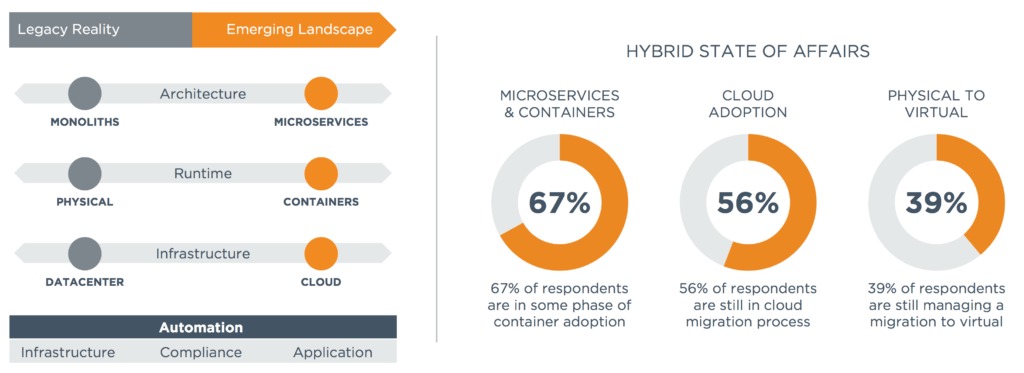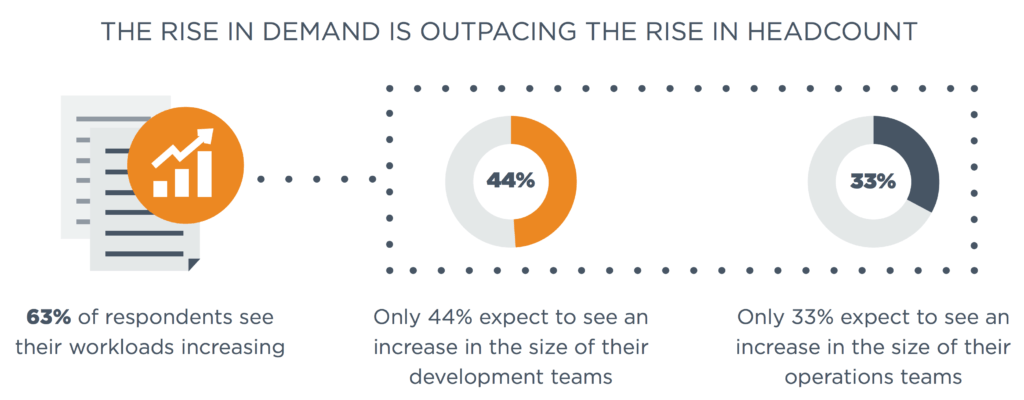The increasing pace of infrastructure technology innovations–the shift to virtual, cloud, containers, and microservices–has changed the meaning of the word “hybrid”. Automation and management solutions that only address one particular infrastructure type or deployment architecture may be well-suited to practices today, but they’re likely to become opinionated relics that reflect the practices of their time.
The changing scope of “hybrid”
A few years ago, the term “hybrid” mostly applied to cloud infrastructure: is it running on-premises or in a public cloud? That distinction seems silly and short-sighted these days. Done right, cloud is cloud. The general rules for how your application teams interact with that infrastructure should be the same regardless of whether it’s in your datacenter or someone else’s. Today, a “hybrid cloud strategy” could just as easily mean your applications utilize two different public cloud providers.
“Most enterprises are going to operate in hybrid mode for many years to come” —Andy Jassy, CEO, Amazon Web Services (re:Invent 2016)
In the last few years, we’ve seen a rapidly accelerating pace of infrastructure technology innovations. Virtualization, cloud, containers, and microservice architectures are changing not only how infrastructure operates but how applications are written.
Most enterprises are in some hybrid state of technology adoption (Chef Survey 2017)
The Chef Survey 2017 shows that 67% of users are in some phase of migrating to microservices & containers, 56% are in some phase of cloud migration, and 39% are still migrating from physical to virtual. The reality is that few companies have a portfolio that consists solely of modern applications and equally the legacy portfolio must continue to perform and integrate with the modern portfolio. Most companies have a hybrid environment that includes a variety of applications whose designs reflect the practices of their time. Hybrid infrastructure for users today more appropriately means the mix of greenfield and brownfield application infrastructures that has accumulated over a few years.
Managing the shift
Further, for any reasonably sized business, new applications are being designed for web-scale and consumer-level experiences. These requirements mean a design point that involves multiple technology shifts such as the shift to becoming cloud-native. These changing requirements are at the heart of progress and, as an industry, we’re embracing them quickly.
DevOps practices apply to managing brownfield and greenfield application deployments alike. It’s critical for any management solution to have the flexibility to manage applications across their entire portfolio–both modern and legacy–for the foreseeable future. Regardless of the particular infrastructure type or deployment architecture, they key for ongoing management is automation.
Many automation solutions exist and new technology vendors each have an approach that may be well-suited to practices today, but are likely to become opinionated relics that reflect the practices of their time. The increasing velocity of technology shifts brings with it the challenge of increased management complexity, which means means increased workloads with each new shift.
Workloads vs. headcount (Chef Survey 2017)
The way forward
Enterprise leaders have realized that the only way to scale the increased complexity of application management without equally scaling headcount is to manage their infrastructure, application, and compliance concerns with consistency and automation across their entire estate.
Find out more about how enterprise leaders are staying ahead of these trends in our whitepaper: Continuous Automation for the Continuous Enterprise.




